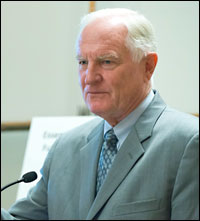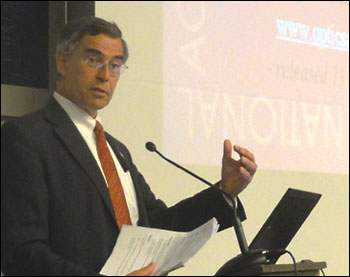
‘The Promise of Optics and Photonics’ Presented on Capitol Hill
WASHINGTON, Sept. 13, 2012 — Members of the optics and photonics community headed to Capitol Hill on Wednesday to draw attention to the National Academy of Sciences' recently released report on the current state of optical sciences and the role they could play in driving US economic growth in the future.
The morning event, "Essential Technologies for Our Future: Optics and Photonics Leading the Way," was sponsored by four optics and photonics industry groups: the American Physical Society (APS), the IEEE Photonics Society, The Optical Society (OSA), and SPIE, the international society for optics and photonics. Its purpose was to raise awareness of the importance of optics and photonics to key stakeholders in US federal agencies, such as the National Institute of Standards and Technology, the National Science Foundation and the Department of Energy.

Keynote speakers on "Essential Technologies for Our Future: Optics and Photonics Leading the Way," a presentation to raise awareness of the importance of optics and photonics to US federal agencies, were (l-r): Committee on Harnessing Light Co-Chairman Alan Willner; US Secretary of Energy Steven Chu; former Intel CEO and President Craig Barrett; Committee on Harnessing Light Co-Chairman Paul McManamon; and OSA Vice President Philip Bucksbaum. The presentation was sponsored by optics and photonics industry groups APS, IEEE Photonics Society, OSA and SPIE. (Photos courtesy of OSA)
The National Academy of Sciences (NAS) released the report, "Optics & Photonics: Essential Technologies for Our Nation," last month. A follow-up to NAS’ Harnessing Light report published in 1998, the study identifies research priorities and grand challenges to fill gaps in optics and photonics. It recommends that the federal government develop such an initiative to foster collaboration between academia, industry and government, and to steer federal R&D funding and activities (See Report Hails Photonics as Hope for US Economy).
Keynote speakers for Wednesday's event included US Secretary of Energy and OSA Honorary Member Steven Chu and former Intel President and CEO Craig Barrett. Both men highlighted the key role optics and photonics technologies play in driving economic growth, creating jobs and enabling future innovations to advance society. Afterward, a briefing was held on Capitol Hill underscoring the same points to members of Congress and their staff.

Former Intel CEO Craig Barrett highlighted the key role optics and photonics technologies play in driving economic growth.
"Optics and photonics are incredibly important to the US economy and its competitiveness in the 21st century," said Barrett in his address to an audience of 100 federal agency staff and others. "Proposals like this [report] are critical to the US, and it's dreadfully important that policymakers not only accept them, but that they do something with it."
"It is our hope that the optics and photonics community will use the Academy's report to bring private industry, universities and government partners together to enable greater economic growth and many more life-enhancing technologies through the expansion of optics and photonics," said OSA Vice President Philip H. Bucksbaum. "As the report concludes, the promise of optics and photonics can be realized if the United States acts now to cultivate this versatile scientific field through collaborative research and development activities and coordinated support from the public, academic and private sectors working together."
The agency launch event also featured an overview of the NAS report’s findings by University of Southern California professor Alan Willner, co-chairman of the Harnessing Light Committee that authored the report; and a summary of the report’s recommendations by fellow co-chairman Paul McManamon of Exciting Technology LLC.
The report names five grand challenges facing the nation that advances in optics and photonics technology can address: keeping up the pace of technological achievement established in previous decades; improving military surveillance and missile defense; achieving cost parity for solar power versus fossil fuel across the country's electrical grid; reaching seamless integration of photonics and electronics at the chip level; and developing optical sources and imaging tools for increased resolution in manufacturing.
It calls for a public-private partnership in the form of a National Photonics Initiative that would focus attention and funding on photonics R&D, seek to clearly outline economic impacts and activities of the industry, and support collaboration across scientific subdisciplines in which optics and photonics play a key role.

Kicking off the "Lighting the Way to American Prosperity" Congressional R&D Caucus briefing on Wednesday was US Rep. Rush Holt (D-N.J.)
The report also was laid out for a Capitol Hill audience as part of the Congressional R&D Caucus briefing on "Lighting the Way to American Prosperity." The event was kicked off by US Rep. Rush Holt (D-N.J.), co-chairman of the Congressional R&D Caucus, and featured prominent optical scientists who have found success in photonics startups, including 2009 OSA President Thomas Baer of Stanford Photonic Research Center, Greg Olsen of Princeton University and Martin Richardson of Townes Laser Institute at the University of Central Florida.
“Today, US agencies and institutions are facing difficult funding decisions due to looming budget cuts and a tight fiscal climate,” Bucksbaum said. “As the federal government determines how to prioritize funding levels for science and technology programs, our community can use this landmark study to support those decisions, as it provides specific examples of the technological and economic value of optics and photonics in a broad range of sectors.”
To download a .pdf of the report summary, visit: http://opticsandphotonics.org. For more information, including OSA’s Executive Summary of its findings, visit: www.osa.org/HarnessingLight.
Published: September 2012